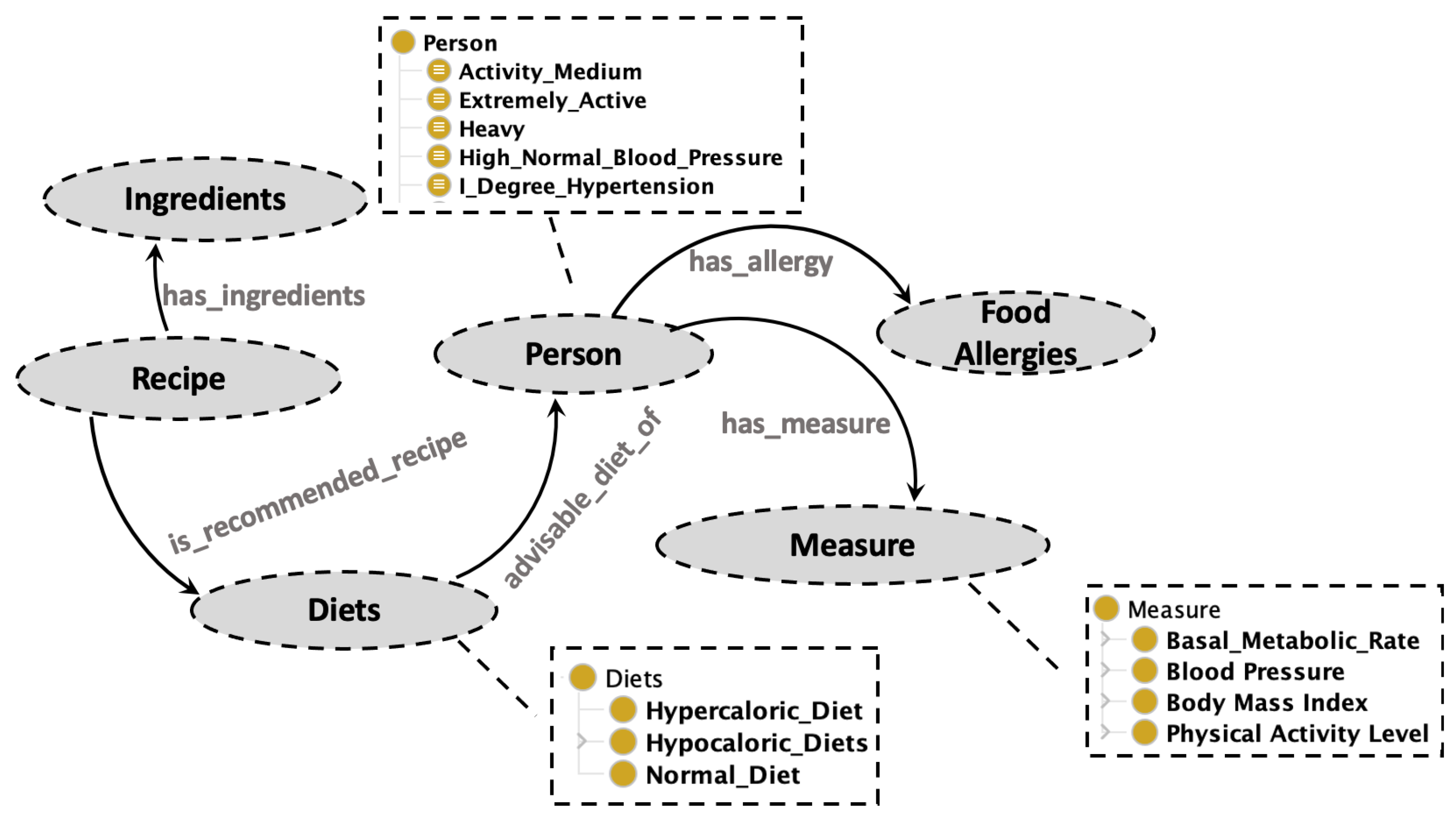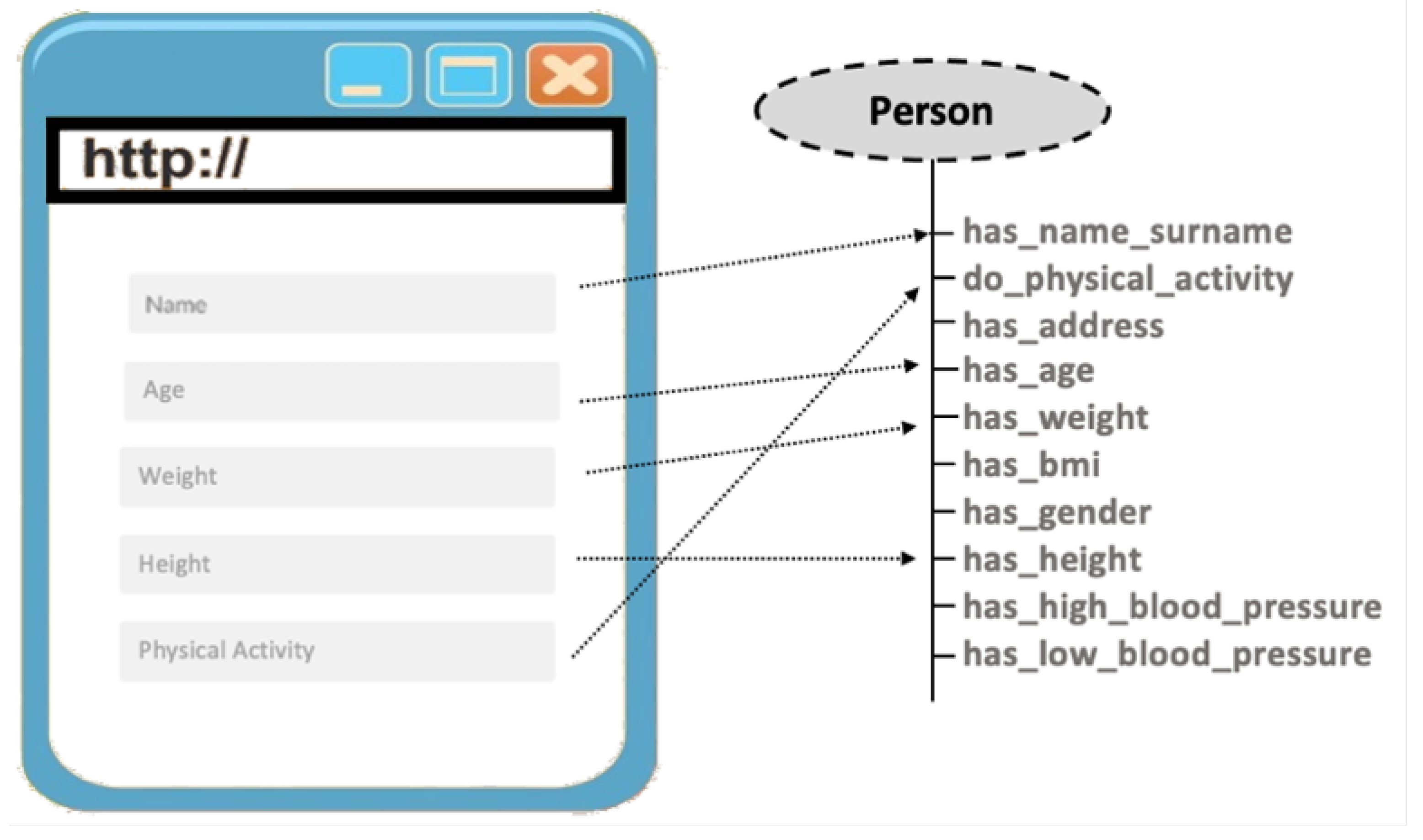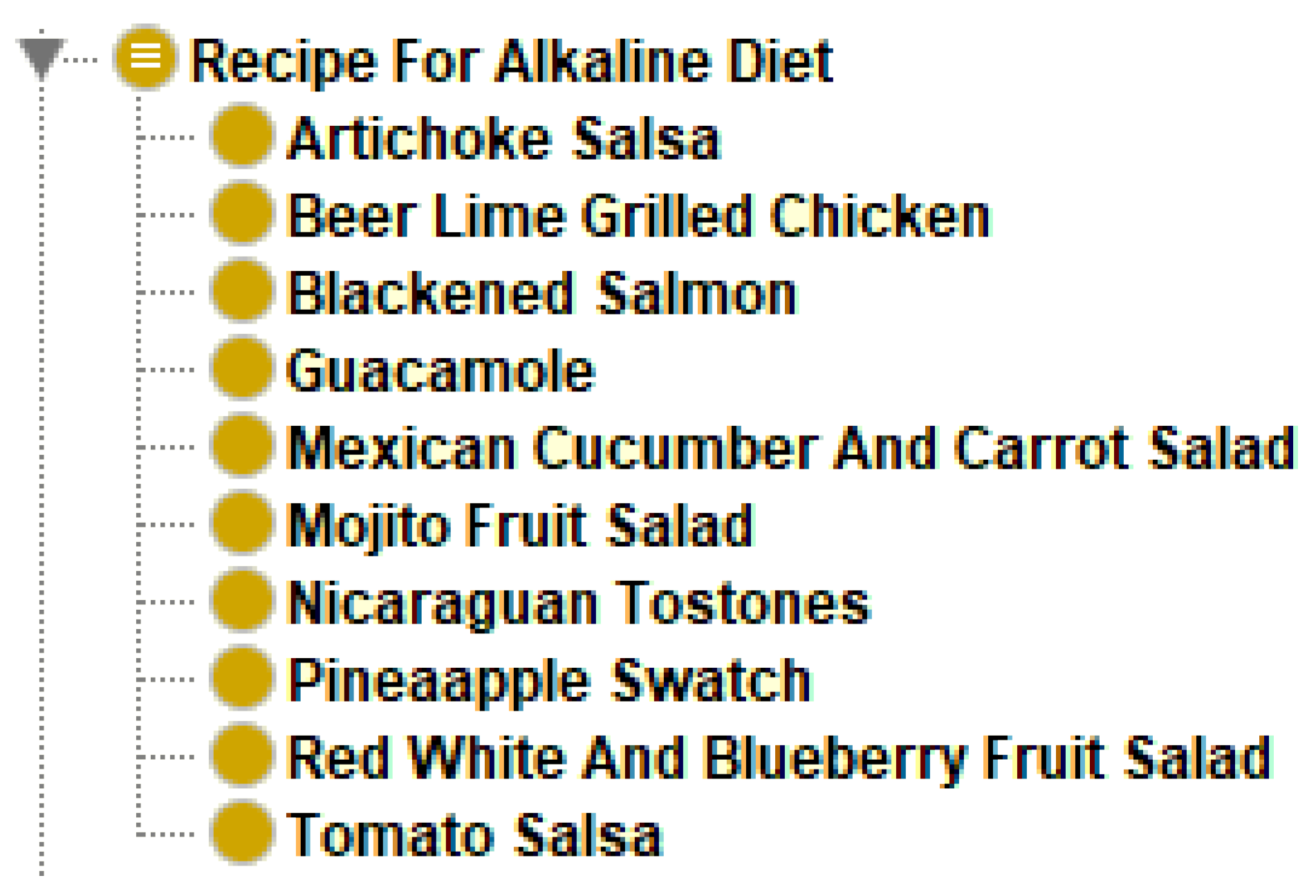Ontology-Based Nutritional Recommender System
Abstract
1. Introduction
- We present the Ontology of Dietary Recommendations (ODR), a shareable conceptual model comprising the most relevant elements in the food recommendation domain including diets, recipes, ingredients, anthropometric indexes, and food allergies;
- A knowledge base built on top of the ODR ontology was used to support the recommendation process. The knowledge base was populated with data about specific diets and recipes gathered from scientific publications and other sources;
- The knowledge base and the underlying ontology schema were developed by adopting the Linked Data best practices (https://www.w3.org/TR/ld-bp/ (accessed on 13 December 2021)). In particular, the ontology is easily extensible with new axioms, and the knowledge base can be updated with the latest advancements in the field;
- We propose a knowledge-based diet recommendation system that infers the most suitable diets given the user’s data and returns a list of recipes that comply with those diets’ composition details. In the prototypical implementation described here, the BMI was used as the main indicator to assess the users’ health status (i.e., their obesity level), and the recommendations are focused on helping with weight loss.
2. State-of-The-Art
2.1. Health and Nutrition Ontologies
2.2. Dietary Recommender Systems
3. Recommender System Architecture
3.1. Ontology of Dietary Recommendations
| Algorithm 1 Mapping ingredients. |
|
3.2. User Data Collector
| Algorithm 2 Populate ontology with a new user (class ). |
|
3.3. Diet Recommender Module
- Step 1: retrieving the new user—At this stage, user’s personal details are transformed into OWL axioms, and the recommender will retrieve such information to make the diet recommendation;
- Step 2: linking diets—Users’ medical conditions are the first factor the system considers for making suggestions. Therefore, the details inserted by users are used to classify their situation and recommend diets accordingly. In Figure 3 above, the axiom utilized for specifying the association between the user’s dietetic profile and diets is shown;
- Step 3: analyzing recipes—Once the diet is assigned, a list of recipes can be recommended considering the ingredients more adequate for users. Figure 8 shows the exemplary taxonomy of Alkaline diet recipes. The classification of such recipes is performed automatically by the reasoner by considering the semantic description of each recipe subclass (see Figure 5 above).
4. Evaluation
4.1. Dataset
4.2. Evaluation Metrics
4.3. Results
4.4. Discussion
5. Conclusions and Future Work
Author Contributions
Funding
Institutional Review Board Statement
Informed Consent Statement
Data Availability Statement
Acknowledgments
Conflicts of Interest
References
- Mehrzad, R. Definition and introduction to epidemiology of obesity. In Obesity; Elsevier: Amsterdam, The Netherlands, 2020; pp. 1–6. [Google Scholar] [CrossRef]
- Hruby, A.; Hu, F.B. The epidemiology of obesity: A big picture. Pharmacoeconomics 2015, 33, 673–689. [Google Scholar] [CrossRef] [PubMed]
- Vatansever, S. Public private partnerships in nutrition education: Policy and evidence from Turkey and The European Union. Ph.D. Thesis, Middle East Technical University, Ankara, Turkey, 2020. [Google Scholar]
- Adab, P.; Pallan, M.; Whincup, P.H. Is BMI the best measure of obesity? BMJ 2018, 360. [Google Scholar] [CrossRef] [PubMed]
- de Vries, J. The obesity epidemic: Medical and ethical considerations. Sci. Eng. Ethics 2007, 13, 55–67. [Google Scholar] [CrossRef] [PubMed]
- Kochkarovich, A.I.; Sultonovna, O.A.; Ravshanovna, A.D. Eating Wisely is the Foundation of a Healthy Lifestyle. Int. J. Integr. Educ. 2020, 3, 175–176. [Google Scholar] [CrossRef]
- Mudambi, S.R.; Rao, S.M.; Rajagopal, M. Food Science; New Age International: Delhi, India, 2015. [Google Scholar]
- Johnson, S. The Importance of Nutrition and Preventing Malnutrition in Older Adults: A Literature Review and Informational Booklet; UNL Digital Commons; University of Nebraska-Lincoln: Lincoln, Nebraska, 2021; Volume 294. [Google Scholar]
- Hitzler, P. A review of the Semantic Web field. Commun. ACM 2021, 64, 76–83. [Google Scholar] [CrossRef]
- García-Díaz, J.A.; Cánovas-García, M.; Valencia-García, R. Ontology-driven aspect-based sentiment analysis classification: An infodemiological case study regarding infectious diseases in Latin America. Future Gener. Comput. Syst. 2020, 112, 641–657. [Google Scholar] [CrossRef]
- Juanes Cortés, B.; Vera-Ramos, J.A.; Lovering, R.C.; Gaudet, P.; Laegreid, A.; Logie, C.; Schulz, S.; del Mar Roldán-García, M.; Kuiper, M.; Fernández-Breis, J.T. Formalization of gene regulation knowledge using ontologies and gene ontology causal activity models. Biochim. Biophys. Acta (BBA)-Gene Regul. Mech. 2021, 1864, 194766. [Google Scholar] [CrossRef] [PubMed]
- Arsic, B.; Ðokic-Petrovic, M.; Spalevic, P.C.; Milentijevic, I.Z.; Rancic, D.D.; Zivanovic, M. SpecINT: A framework for data integration over cheminformatics and bioinformatics RDF repositories. Semant. Web 2019, 10, 795–813. [Google Scholar] [CrossRef]
- Rodríguez-García, M.Á.; García-Sánchez, F.; Valencia-García, R. Knowledge-Based System for Crop Pests and Diseases Recognition. Electronics 2021, 10, 905. [Google Scholar] [CrossRef]
- Studer, R.; Benjamins, V.R.; Fensel, D. Knowledge Engineering: Principles and Methods. Data Knowl. Eng. 1998, 25, 161–197. [Google Scholar] [CrossRef]
- Dostálová, J. LOW-FAT FOODS | Low-fat Spreads. In Encyclopedia of Food Sciences and Nutrition, 2nd ed.; Caballero, B., Ed.; Academic Press: Oxford, UK, 2003; pp. 3617–3622. [Google Scholar] [CrossRef]
- Moodie, R.; Stuckler, D.; Monteiro, C.; Sheron, N.; Neal, B.; Thamarangsi, T.; Lincoln, P.; Casswell, S. Profits and pandemics: Prevention of harmful effects of tobacco, alcohol, and ultra-processed food and drink industries. Lancet 2013, 381, 670–679. [Google Scholar] [CrossRef]
- Tóthová, V.; Bártlová, S.; Šedová, L.; Olišarová, V.; Prokešová, R.; Adámková, V.; Mauritzová, I.; Treslova, M.; Chloubová, I.; Mikšová, Z. The importance of self-management in the prevention and treatment of excessive weight and obesity. Neuro Endocrinol. Lett. 2015, 36, 5–10. [Google Scholar] [PubMed]
- Tran, T.N.T.; Atas, M.; Felfernig, A.; Stettinger, M. An overview of recommender systems in the healthy food domain. J. Intell. Inf. Syst. 2018, 50, 501–526. [Google Scholar] [CrossRef]
- Trattner, C.; Elsweiler, D. Food recommender systems: Important contributions, challenges and future research directions. arXiv 2017, arXiv:1711.02760. [Google Scholar]
- Dooley, D.; Andrés-Hernández, L.; Bordea, G.; Carmody, L.; Cavalieri, D.; Chan, L.E.; Castellano-Escuder, P.; Lachat, C.; Mougin, F.; Vitali, F.; et al. OBO Foundry Food Ontology Interconnectivity. In Proceedings of the Joint Ontology Workshops 2021 Episode VII: The Bolzano Summer of Knowledge co-located with the 12th International Conference on Formal Ontology in Information Systems (FOIS 2021), and the 12th International Conference on Biomedical Ontologies (ICBO 2021), Bolzano, Italy, 11–18 September 2021; Volume 2969. [Google Scholar]
- Castellano-Escuder, P.; González-Domínguez, R.; Wishart, D.S.; Andres-Lacueva, C.; Sánchez-Pla, A. FOBI: An ontology to represent food intake data and associate it with metabolomic data. Database J. Biol. Databases Curation 2020, 2020. [Google Scholar] [CrossRef] [PubMed]
- Paredes-Valverde, M.A.; del Pilar Salas-Zárate, M.; Colomo-Palacios, R.; Gómez-Berbís, J.M.; Valencia-García, R. An ontology-based approach with which to assign human resources to software projects. Sci. Comput. Program. 2018, 156, 90–103. [Google Scholar] [CrossRef]
- García-Sánchez, F.; Colomo-Palacios, R.; Valencia-García, R. A social-semantic recommender system for advertisements. Inf. Process. Manag. 2020, 57, 102153. [Google Scholar] [CrossRef]
- Kiong, Y.C.; Palaniappan, S.; Yahaya, N.A. Health ontology system. In Proceedings of the 2011 7th International Conference on Information Technology in Asia, Sarawak, Malaysia, 12–13 July 2011; pp. 1–4. [Google Scholar] [CrossRef]
- Liyanage, H.; Krause, P.; De Lusignan, S. Using ontologies to improve semantic interoperability in health data. BMJ Health Care Inform. 2015, 22. [Google Scholar] [CrossRef] [PubMed]
- Hadzic, M.; Chen, M.; Dillon, T.S. Towards the Mental Health Ontology. In Proceedings of the 2008 IEEE International Conference on Bioinformatics and Biomedicine, BIBM 2008, Philadephia, PA, USA, 3–5 November 2008; Chen, X., Hu, X., Kim, S., Eds.; IEEE Computer Society: Washington, DC, USA, 2008; pp. 284–288. [Google Scholar] [CrossRef]
- Schriml, L.M.; Arze, C.; Nadendla, S.; Chang, Y.W.; Mazaitis, M.; Felix, V.; Feng, G.; Kibbe, W.A. Disease Ontology: A backbone for disease semantic integration. Nucleic Acids Res. 2012, 40, 940–946. [Google Scholar] [CrossRef] [PubMed]
- Legaz-García, M.C.; Martínez-Costa, C.; Menárguez-Tortosa, M.; Fernández-Breis, J.T. A semantic web based framework for the interoperability and exploitation of clinical models and EHR data. Knowl. Based Syst. 2016, 105, 175–189. [Google Scholar] [CrossRef]
- Malhotra, A.; Younesi, E.; Gündel, M.; Müller, B.; Heneka, M.T.; Hofmann-Apitius, M. ADO: A disease ontology representing the domain knowledge specific to Alzheimer’s disease. Alzheimer’s Dement. 2014, 10, 238–246. [Google Scholar] [CrossRef]
- He, Y.; Yu, H.; Ong, E.; Wang, Y.; Liu, Y.; Huffman, A.; Huang, H.H.; Beverley, J.; Hur, J.; Yang, X.; et al. CIDO, a community-based ontology for coronavirus disease knowledge and data integration, sharing, and analysis. Sci. Data 2020, 7, 181. [Google Scholar] [CrossRef] [PubMed]
- Hastings, J.; Owen, G.; Dekker, A.; Ennis, M.; Kale, N.; Muthukrishnan, V.; Turner, S.; Swainston, N.; Mendes, P.; Steinbeck, C. ChEBI in 2016: Improved services and an expanding collection of metabolites. Nucleic Acids Res. 2016, 44, 1214–1219. [Google Scholar] [CrossRef]
- Groza, T.; Köhler, S.; Moldenhauer, D.; Vasilevsky, N.; Baynam, G.; Zemojtel, T.; Schriml, L.M.; Kibbe, W.A.; Schofield, P.N.; Beck, T.; et al. The human phenotype ontology: Semantic unification of common and rare disease. Am. J. Hum. Genet. 2015, 97, 111–124. [Google Scholar] [CrossRef] [PubMed]
- El-Sappagh, S.H.A.; Kwak, D.; Ali, F.; Kwak, K.S. DMTO: A realistic ontology for standard diabetes mellitus treatment. J. Biomed. Semant. 2018, 9, 8:1–8:30. [Google Scholar] [CrossRef]
- Yang, C.; Ambayo, H.; De Baets, B.; Kolsteren, P.; Thanintorn, N.; Hawwash, D.; Bouwman, J.; Bronselaer, A.; Pattyn, F.; Lachat, C. An ontology to standardize research output of nutritional epidemiology: From paper-based standards to linked content. Nutrients 2019, 11, 1300. [Google Scholar] [CrossRef]
- Gharibi, M.; Zachariah, A.; Rao, P. FoodKG: A Tool to Enrich Knowledge Graphs Using Machine Learning Techniques. Front. Big Data 2020, 3, 12. [Google Scholar] [CrossRef]
- Ertugrul, D.Ç. FoodWiki: A Mobile App Examines Side Effects of Food Additives Via Semantic Web. J. Med. Syst. 2016, 40, 41:1–41:15. [Google Scholar] [CrossRef]
- Zhang, X.; Ferreira, P.; de Matos, M.G.; Belo, R. Welfare Properties of Profit Maximizing Recommender Systems: Theory and Results from a Randomized Experiment. MIS Q. 2021, 45. [Google Scholar] [CrossRef]
- Zhang, F.; Qi, S.; Liu, Q.; Mao, M.; Zeng, A. Alleviating the data sparsity problem of recommender systems by clustering nodes in bipartite networks. Expert Syst. Appl. 2020, 149, 113346. [Google Scholar] [CrossRef]
- Bobadilla, J.; Ortega, F.; Hernando, A.; Gutiérrez, A. Recommender systems survey. Knowl. Based Syst. 2013, 46, 109–132. [Google Scholar] [CrossRef]
- Shu, J.; Shen, X.; Liu, H.; Yi, B.; Zhang, Z. A content-based recommendation algorithm for learning resources. Multim. Syst. 2018, 24, 163–173. [Google Scholar] [CrossRef]
- Chen, Q.; Lin, J.; Zhang, Y.; Ding, M.; Cen, Y.; Yang, H.; Tang, J. Towards Knowledge-Based Recommender Dialog System. In Proceedings of the 2019 Conference on Empirical Methods in Natural Language Processing and the 9th International Joint Conference on Natural Language Processing, EMNLP-IJCNLP 2019, Hong Kong, China, 3–7 November 2019; Inui, K., Jiang, J., Ng, V., Wan, X., Eds.; Association for Computational Linguistics: Stroudsburg, PA, USA, 2019; pp. 1803–1813. [Google Scholar] [CrossRef]
- Rodríguez-García, M.Á.; Valencia-García, R.; Colomo-Palacios, R.; Gómez-Berbís, J.M. BlindDate recommender: A context-aware ontology-based dating recommendation platform. J. Inf. Sci. 2019, 45. [Google Scholar] [CrossRef]
- Agapito, G.; Simeoni, M.; Calabrese, B.; Care, I.; Lamprinoudi, T.; Guzzi, P.H.; Pujia, A.; Fuiano, G.; Cannataro, M. DIETOS: A dietary recommender system for chronic diseases monitoring and management. Comput. Methods Progr. Biomed. 2018, 153, 93–104. [Google Scholar] [CrossRef]
- Pecune, F.; Callebert, L.; Marsella, S. A Recommender System for Healthy and Personalized Recipes Recommendations. In Proceedings of the 5th International Workshop on Health Recommender Systems co-located with the 14th ACM Conference on Recommender Systems 2020 (RecSys 2020), Rio de Janeiro, Brazil, 26 September 2020; Said, A., Schäfer, H., Torkamaan, H., Trattner, C., Eds.; ACM: New York, NY, USA, 2020; Volume 2684, pp. 15–20. [Google Scholar]
- Toledo, R.Y.; Alzahrani, A.A.; Martínez, L. A Food Recommender System Considering Nutritional Information and User Preferences. IEEE Access 2019, 7, 96695–96711. [Google Scholar] [CrossRef]
- Ting, Y.H.; Zhao, Q.; Chen, R.C. Dietary recommendation based on recipe ontology. In Proceedings of the 2014 IEEE 6th International Conference on Awareness Science and Technology (iCAST), Paris, France, 29–31 October 2014; pp. 1–6. [Google Scholar] [CrossRef]
- Tumnark, P.; Oliveira, L.; Santibutr, N. Ontology-Based Personalized Dietary Recommendation for Weightlifting. In 2013 International Workshop on Computer Science in Sports; Atlantis Press: Paris, France, 2013; pp. 44–49. [Google Scholar] [CrossRef]
- Horrocks, I.; Patel-Schneider, P.F.; Boley, H.; Tabet, S.; Grosof, B.; Dean, M. SWRL: A Semantic Web rule language combining OWL and RuleML. W3C Memb. Submiss. 2004, 21, 1–31. [Google Scholar]
- Weir, C.B.; Jan, A. BMI Classification Percentile And Cut Off Points; StatPearls Publishing: Treasure Island, FL, USA, 2021. [Google Scholar]
- Anton, S.D.; Hida, A.; Heekin, K.; Sowalsky, K.; Karabetian, C.; Mutchie, H.; Leeuwenburgh, C.; Manini, T.M.; Barnett, T.E. Effects of popular diets without specific calorie targets on weight loss outcomes: Systematic review of findings from clinical trials. Nutrients 2017, 9, 822. [Google Scholar] [CrossRef]
- Golay, A.; Allaz, A.; Ybarra, J.; Bianchi, P.; Saraiva, S.; Mensi, N.; Gomis, R.; De Tonnac, N. Similar weight loss with low-energy food combining or balanced diets. Int. J. Obes. 2000, 24, 492–496. [Google Scholar] [CrossRef][Green Version]
- del Castillo, J.M.S.; Llobell, M.I.Z. Miracle diets: When eating guidelines cause health problems. MÈTode Sci. Stud. J. 2021, 11, 147–153. [Google Scholar]
- W3C OWL Working Group. OWL 2 Web Ontology Language. Document Overview (Second Edition). 2012. Available online: https://www.w3.org/TR/owl2-overview/ (accessed on 10 November 2021).
- Palechor, F.M.; de la Hoz Manotas, A. Dataset for estimation of obesity levels based on eating habits and physical condition in individuals from Colombia, Peru and Mexico. Data Br. 2019, 25, 104344. [Google Scholar] [CrossRef]
- Salton, G.; McGill, M.J. Introduction to Modern Information Retrieval; McGraw-Hill: New York, NY, USA, 1983. [Google Scholar]
- Manoharan, S. Patient diet recommendation system using K clique and deep learning classifiers. J. Artif. Intell. Capsul. Netw. 2020, 2, 121–130. [Google Scholar] [CrossRef]
- Chavan, P.; Thoms, B.; Isaacs, J.T. A Recommender System for Healthy Food Choices: Building a Hybrid Model for Recipe Recommendations using Big Data Sets. In Proceedings of the 54th Hawaii International Conference on System Sciences, HICSS 2021, Kauai, HI, USA, 5 January 2021; pp. 1–10. [Google Scholar]
- Shrimal, M.; Khavnekar, M.; Thorat, S.; Deone, J. Nutriflow: A Diet Recommendation System. 2021. Available online: https://ssrn.com/abstract=3866863 (accessed on 17 December 2021).
- Rippe, J.M.; Crossley, S.; Ringer, R. Obesity as a chronic disease: Modern medical and lifestyle management. J. Am. Diet. Assoc. 1998, 98, S9–S15. [Google Scholar] [CrossRef]
- Haregu, T.N.; Oti, S.; Egondi, T.; Kyobutungi, C. Measurement of overweight and obesity an urban slum setting in sub-Saharan Africa: A comparison of four anthropometric indices. BMC Obes. 2016, 3, 46. [Google Scholar] [CrossRef]








 | |
|---|---|
 | |
 | |
 | |
 | |
 | |
 | |
 |
| Metrics | |
|---|---|
| Axioms | 5733 |
| Logic Axioms | 2815 |
| Classes | 1193 |
| Object Properties | 21 |
| Data Properties | 23 |
| Type | Instances |
|---|---|
| Insufficient | 272 |
| Normal | 287 |
| Overweight | 580 |
| Obesity Type I | 351 |
| Obesity Type II | 297 |
| Obesity Type III | 324 |
| Profile | Accuracy | Precision | Recall | F-Measure |
|---|---|---|---|---|
| Normal | 0.84 | 0.34 | 0.77 | 0.47 |
| Overweight | 0.92 | 0.84 | 0.97 | 0.90 |
| Obesity Type I | 0.86 | 0.72 | 0.94 | 0.81 |
| Obesity Type II | 0.84 | 0.71 | 0.93 | 0.80 |
| Obesity Type III | 0.85 | 0.71 | 0.93 | 0.80 |
| Overall | 0.87 | 0.7 | 0.92 | 0.78 |
Publisher’s Note: MDPI stays neutral with regard to jurisdictional claims in published maps and institutional affiliations. |
© 2021 by the authors. Licensee MDPI, Basel, Switzerland. This article is an open access article distributed under the terms and conditions of the Creative Commons Attribution (CC BY) license (https://creativecommons.org/licenses/by/4.0/).
Share and Cite
Mckensy-Sambola, D.; Rodríguez-García, M.Á.; García-Sánchez, F.; Valencia-García, R. Ontology-Based Nutritional Recommender System. Appl. Sci. 2022, 12, 143. https://doi.org/10.3390/app12010143
Mckensy-Sambola D, Rodríguez-García MÁ, García-Sánchez F, Valencia-García R. Ontology-Based Nutritional Recommender System. Applied Sciences. 2022; 12(1):143. https://doi.org/10.3390/app12010143
Chicago/Turabian StyleMckensy-Sambola, Dexon, Miguel Ángel Rodríguez-García, Francisco García-Sánchez, and Rafael Valencia-García. 2022. "Ontology-Based Nutritional Recommender System" Applied Sciences 12, no. 1: 143. https://doi.org/10.3390/app12010143
APA StyleMckensy-Sambola, D., Rodríguez-García, M. Á., García-Sánchez, F., & Valencia-García, R. (2022). Ontology-Based Nutritional Recommender System. Applied Sciences, 12(1), 143. https://doi.org/10.3390/app12010143









